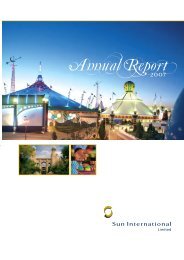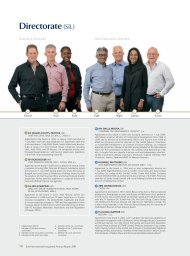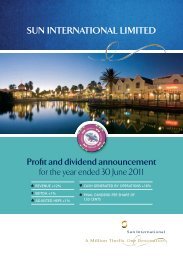PDF 25 MB - Sun International | Investor Centre
PDF 25 MB - Sun International | Investor Centre
PDF 25 MB - Sun International | Investor Centre
You also want an ePaper? Increase the reach of your titles
YUMPU automatically turns print PDFs into web optimized ePapers that Google loves.
elating to certain firm commitments and forecasted transactions. These<br />
derivatives are initially measured at fair value on the contract date, and<br />
are remeasured to fair value at subsequent reporting dates. The resulting<br />
gain or loss is recognised in profit for the year as it arises unless the<br />
derivative is designated and effective as a hedging instrument. The group<br />
designates certain derivatives as either hedges of the fair value of recognised<br />
assets or liabilities or firm commitments (fair value hedges), hedges of<br />
highly probable forecast transactions, hedges of foreign currency risk of<br />
firm commitments (cash flow hedges) or hedges of net investments in<br />
foreign operations.<br />
Cash flow hedges<br />
Changes in the fair value of derivative financial instruments that are<br />
designated and effective as hedges of future cash flows are recognised<br />
directly in other comprehensive income. The ineffective portion is recognised<br />
immediately in profit for the year in the respective line items. Amounts<br />
deferred to the hedging reserve are recognised through profit and loss in<br />
the same period in which the hedged item affects profit and loss. Hedge<br />
accounting is discontinued when the hedging instrument expires or is<br />
sold, terminated, or exercised, or no longer qualifies for hedge accounting.<br />
At that time, for forecast transactions, any cumulative gain or loss on the<br />
hedging instrument recognised in the hedging reserve is retained until the<br />
forecasted transaction occurs. If a hedged transaction is no longer expected<br />
to occur, the net cumulative gain or loss recognised in the hedging reserve<br />
is transferred to profit or loss for the period.<br />
CURRENT AND DEFERRED TAX<br />
The tax expense for the period comprises current and deferred tax. Tax is<br />
recognised in the statement of comprehensive income, except to the extent<br />
that it relates to items recognised directly in equity.<br />
Deferred tax is provided in full, using the liability method, for all temporary<br />
differences arising between the tax bases of assets and liabilities and their<br />
carrying amounts for financial reporting purposes.<br />
Current tax and deferred tax are calculated on the basis of tax laws enacted<br />
or substantively enacted at the financial reporting date in the countries<br />
where it is applicable.<br />
Deferred tax assets relating to the carry forward of tax losses are recognised<br />
to the extent that it is probable that future taxable profit will be available<br />
against which the unused tax losses can be utilised in the foreseeable future.<br />
SECONDARY TAX<br />
STC is provided in respect of dividends declared on ordinary shares net of<br />
dividends received or receivable and is recognised as a tax charge for the<br />
year in which the dividend is declared.<br />
LEASES<br />
Leases of assets where the group assumes substantially all the benefits<br />
and risks of ownership are classified as finance leases. Finance leases are<br />
capitalised at inception at the lower of the fair value of the leased property<br />
ACCOUNTING POLICIES continued<br />
and the present value of the minimum lease payments. Each lease payment<br />
is allocated between the liability and finance charges so as to achieve a<br />
constant rate on the finance balance outstanding. The corresponding lease<br />
obligations, net of finance charges, are included in borrowings. The interest<br />
element of the lease payment is charged to the statement of comprehensive<br />
income over the lease period. The assets acquired under finance leasing<br />
contracts are depreciated over the shorter of the useful life of the asset or<br />
the lease period. Where a lease has an option to be renewed the renewal<br />
period is considered when the period over which the asset will be<br />
depreciated is determined.<br />
Leases of assets under which substantially all the risks and benefits of<br />
ownership are effectively retained by the lessor are classified as operating<br />
leases. Payments made under operating leases are charged to the statement<br />
of comprehensive income on a straight-line basis over the period of<br />
the lease.<br />
When an operating lease is terminated before the lease period has expired,<br />
any payment required to be made to the lessor by way of a penalty is<br />
recognised as an expense in the period in which termination takes place.<br />
BORROWINGS<br />
Borrowings, inclusive of transaction costs, are initially recognised at fair<br />
value. Borrowings are subsequently stated at amortised cost using the<br />
effective interest rate method; any difference between proceeds and the<br />
redemption value is recognised in the statement of comprehensive income<br />
over the period of the borrowing using the effective interest rate method.<br />
Preference shares, which are redeemable on a specific date or at the<br />
option of the shareholder or which carry non-discretionary dividend<br />
obligations, are classified as borrowings. The dividends on these preference<br />
shares are recognised in the statement of comprehensive income as interest<br />
expense. STC is accrued on recognition of the expense.<br />
Borrowings are classified as current liabilities unless the group has an<br />
unconditional right to defer settlement of the liability for at least 12 months<br />
after the end of the reporting period.<br />
EMPLOYEE BENEFITS<br />
Defined benefit scheme<br />
The group operates a closed defined benefit pension scheme. The defined<br />
benefit pension scheme is funded through payments to a trustee-administered<br />
fund, determined by reference to periodic actuarial calculations. The defined<br />
benefit plan defines an amount of pension benefit that an employee will<br />
receive on retirement, usually dependent on one or more factors such as age,<br />
years of service and compensation.<br />
The asset or liability, as applicable, recognised in the statement of financial<br />
position in respect of the defined benefit pension plan is the present value<br />
of the defined benefit obligation at the end of the reporting period less<br />
the fair value of plan assets, together with adjustments for unrecognised<br />
actuarial gains or losses, past service costs and any asset ceiling which may<br />
apply. The defined benefit obligation is calculated annually by independent<br />
147










